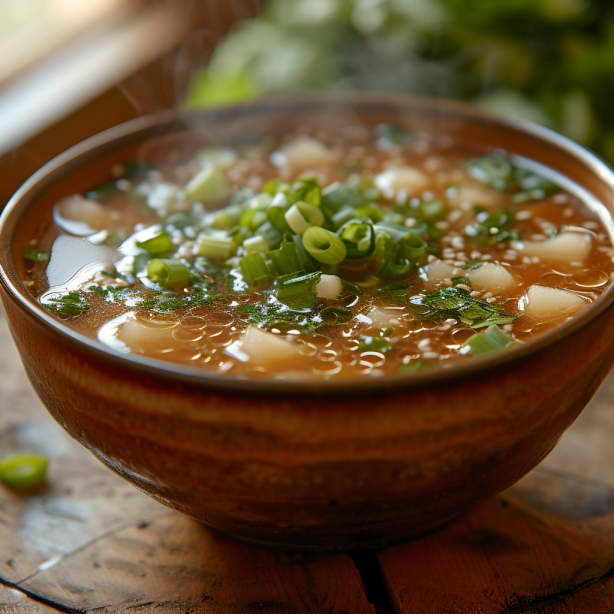According to chef Martin, “Using fresh ingredients is key to creating low-sodium Chinese soups.”
The tantalizing flavors of Chinese cuisine can be enjoyed without…
… excess sodium when care is taken in sourcing and preparation.
Many classic Chinese soup recipes can be adapted to be heart-healthy…
… and hydrating options for any meal.
With clever use of aromatics, spices, vinegars, and stocks, it’s possible to craft broths…
… packed with complex flavors that will make your mouth water without spiking your blood pressure.
Let’s explore easy ways to put a new spin on soups like…
…egg drop, hot and sour, and vegetable soup by lowering the salt while amping up nutrition.
KEY TAKEAWAY
Lowest sodium Chinese soup, what to know?
Lowest sodium Chinese soups include options like vegetable broth, reduced-sodium…
… hot and sour soup, and clear soups with lean proteins such as…
… chicken or tofu, all prepared with minimal salt and soy sauce for a healthier choice.
Opting for herbal-infused soups with fresh ingredients is also recommended…
… to maintain a low-sodium intake.
What are the lowest sodium Chinese soups?
Egg drop soup
Egg drop soup offers a light yet flavorful option as it GENERALLY HAS very little sodium already.
The main ingredients are just broth and eggs, which contain barely any salt.
Be sure to choose a LOW-SODIUM chicken broth to cut back even more.
Wonton soup
The WONTONS in wonton soup are low in sodium on their own.
Opt for homemade wontons or ones with simple fillings like shrimp and pork to keep sodium in check.
Similarly, WONTON soup stays light when using a LOW-SODIUM broth instead of a regular or canned one.
Hot and sour soup
This peppery soup can still satisfy without overdoing the sodium. (1)
Look for HOT AND SOUR soup recipes that go easy on soy sauce, using only a little…
… LIGHT SOY SAUCE and DARK SOY SAUCE to add flavor as these tend…
… to be higher in sodium than other ingredients.
Choosing a LOW-SODIUM broth is important for this soup too.
For bolder flavor, bamboo shoots and fresh SHIITAKE MUSHROOMS are great low-sodium add-ins.
Tips for reducing sodium in Chinese soups

When cooking Chinese soups at home, there are several tweaks you can make…
… to lower the sodium while keeping a rich flavor. (2)
Opt for LOW-SODIUM varieties of common soup bases…
… like SOY SAUCE, OYSTER SAUCE, and BROTH.
Read labels carefully – you’d be surprised how much the sodium can vary!
For instance, cutting a regular soy sauce in half with a low-sodium option…
… easily trims hundreds of milligrams.
Be mindful of adding extra SALT to taste.
Many Chinese soup recipes are already salty due to ingredients like soy sauce.
Try omitting additional salt first before seasoning further.
Rather than pickled or cured foods high in hidden salt, pick fresh ingredients when possible.
rinsed canned legumes or veggies lose some of their sodium payload too.
Aromatics like minced GARLIC and GRATED GINGER pack plenty of savory punch with zero salt.
Stock your pantry with these and HERBS as healthy sodium-free seasoning swaps.
Finally, cornstarch or corn meal form a naturally thickened broth base…
… for soups like HOT AND SOUR SOUP without extra salt.
Just be sure to follow amounts carefully – a little goes a long way.
With practice, your homemade Chinese soups can truly satisfy any SOUP RECIPES craving.
Homemade low-sodium Chinese soup recipes
These simple recipes allow you to enjoy Chinese soups from the comfort…
… of your kitchen – with far less sodium than restaurant staples.
Egg Drop Soup

Ingredients:
- 1 liter LOW-SODIUM CHICKEN STOCK
- 2 eggs
- 2 GREEN ONIONS thinly sliced
Directions:
- Bring stock to a gentle simmer in a SOUP POT.
- Lightly beat eggs in a SMALL BOWL.
- Slowly DRIPPLE beaten eggs into stock in a thin stream, stirring constantly with chopsticks or a fork until eggs form long RIBBON-like strands.
- Remove from heat and add green onions.
Hot and Sour Soup

Ingredients:
- 1 liter low-sodium vegetable or chicken stock
- 8 dried shiitake mushrooms, stemmed and sliced
- 1⁄2 cup sliced bamboo shoots, rinsed and drained
- 1 block firm tofu (about 1⁄2 pound), cut into 1⁄2-inch cubes
- 2 tbsp low-sodium soy sauce
- 1 tbsp corn starch
- 2 tbsp water
- White pepper, to taste
Directions:
- In a large pot, bring the stock to a boil over high heat. Add the shiitake mushrooms, cover and remove from heat. Let sit for 15 minutes until softened.
- Drain and reserve the mushrooms, slicing any large pieces. Return the soaked mushrooms to the pot.
- Add the bamboo shoots, tofu and soy sauce. Bring to a gentle simmer.
- In a small bowl, mix the corn starch with water until dissolved to form a cornstarch slurry.
- Slowly drizzle the cornstarch slurry into the simmering soup while whisking constantly. Continue whisking for 1 minute until slightly thickened.
- Taste and season with white pepper if desired.
- Serve hot, garnishing individual bowls with extra soy sauce and white pepper on the side if liked. Enjoy!
Vegetable Soup

Ingredients:
- 1 liter low-sodium vegetable or chicken stock
- 1 cup sliced carrots (about 2 medium carrots, peeled and cut into thin half-moons)
- 1 cup roughly chopped bok choy (substitute Chinese cabbage/napa cabbage, if preferred)
- 1 cup shredded napa cabbage
- 1/4 cup dried wood ear mushrooms, soaked in hot water for 30 minutes until soft, drained and sliced
Directions:
- Add the stock to a large pot and bring to a boil over high heat.
- Carefully add the carrots and cook for 2 minutes. Stir occasionally.
- Add the bok choy, napa cabbage and wood ear mushrooms. Give it all a good stir.
- Now turn the heat down to low so it’s just simmering. Let it bubble away for 10-15 minutes. Stir every now and then.
- The carrots should be tender when pierced with a fork. Everything will have softened nicely.
- Taste the broth and add salt and pepper if you want.
- Enjoy your healthy, filling vegetable soup! It’s easy on your tummy and very tasty too. You can change up the veggies to whatever looks yummy and is in season.
These easy ASIAN SOUP recipes let you enjoy Chinese classics with just a fraction of the sodium of restaurant fare.
Print or pin the FULL RECIPE for your next healthy homemade meal.
Tips for ordering low-sodium soups outside the home
Even when dining out, you can find Chinese soups that fit into your low-sodium diet.
A little planning goes a long way.
First, ask your server about making any soup without added salt.
Many restaurants are happy to accommodate.
You can also request SAUCES and SEASONINGS be served on the side…
… so you control how much is added.
Opt for clear broth soupsfeaturing mainly vegetables.
These tend to be lower in sodium than thicker, CREAMY styles.
Broth-based dishes like hot and sour are generally better bets than cream of mushroom.
When possible, pick seafood or vegetable dishes prepared by STIR FRY or steaming instead of frying.
Fried foods tend to get seasoned more.
Even at Chinese eateries, steamed options can satisfy tastes.
Some soups to consider asking for: Hot and sour soup made without…
… salt, EGG DROP SOUP following a heart-healthy recipe, or vegetable soup…
… with WOOD EAR mushrooms.
It’s wise to inquire about exact SOUP INGREDIENTS and preparation method.
With a little sleuthing you can find healthy Chinese soups anywhere.
Frequently Asked Questions
Can I make low sodium Chinese soup at home?
Yes, use low sodium soy sauce, chicken stock, sesame oil, green onions, and rice vinegar.
How can I enhance the flavor of low sodium hot and sour soup?
Add thinly sliced veggies, black and white pepper, and a cornstarch slurry for delicious flavor.
Is it possible to enjoy low sodium Chinese soup at a restaurant?
Yes, ask for low sodium soy sauce, choose dishes with fresh ingredients for a healthier option.
Conclusion
Preparing tasty, low-sodium Chinese soups takes some creativity and care when selecting ingredients.
By using more fresh vegetables, herbs, spices, vinegars, and stocks instead of…
… salt for flavor, it’s easy to make broths that are full of taste without being high in sodium.
Meats can be seasoned and marinated ahead of time with salt-free rubs.
Standard soup recipes can be adapted by replacing salty condiments…
… with vinegars, citrus, garlic, ginger and other zesty options.
With the right preparation techniques and ingredient substitutions, classic soups…
…can be just as comforting and delicious while being a heart-healthy, nutritious choice.
Comment below with your best tips and favorite go-to Chinese soup recipes made for a low-sodium diet!
References
- https://www.sans-salt.com/post/low-sodium-hot-and-sour-soup
- https://www.thespruceeats.com/using-less-salt-in-chinese-cooking-694623
Related Articles
- https://bowlakechinese.com/what-chinese-food-is-low-in-sodium/
- https://bowlakechinese.com/low-sodium-chinese-food-recipes/
- https://bowlakechinese.com/low-sodium-mapo-tofu/
Was this helpful?

I am a skilled chef assistant with a passion for Asian cuisine, I have honed my craft through formal training at At-Sunrice GlobalChef Academy and years of experience in the culinary industry. I have extensive knowledge of cooking techniques and herbs and spices, with a particular focus on traditional Chinese dishes. I’m also an author of the book “Delicious Keto Low Carb Chinese Food for Busy Moms and Fitness Enthusiasts” which is sold on Amazon. On my blog, bowlakechinese.com, I share my expertise in Asian cuisine and provide tips and recipes for those interested in low carb Chinese cuisine.

